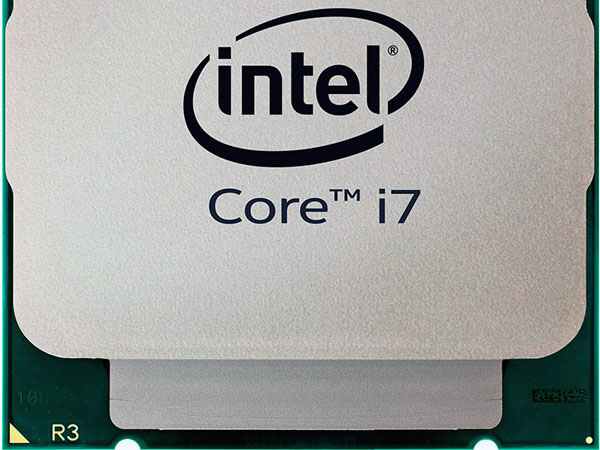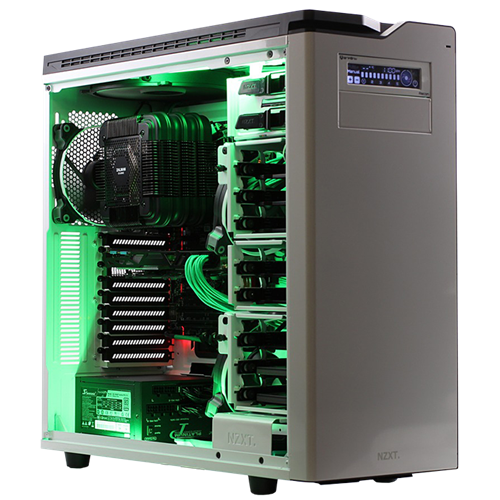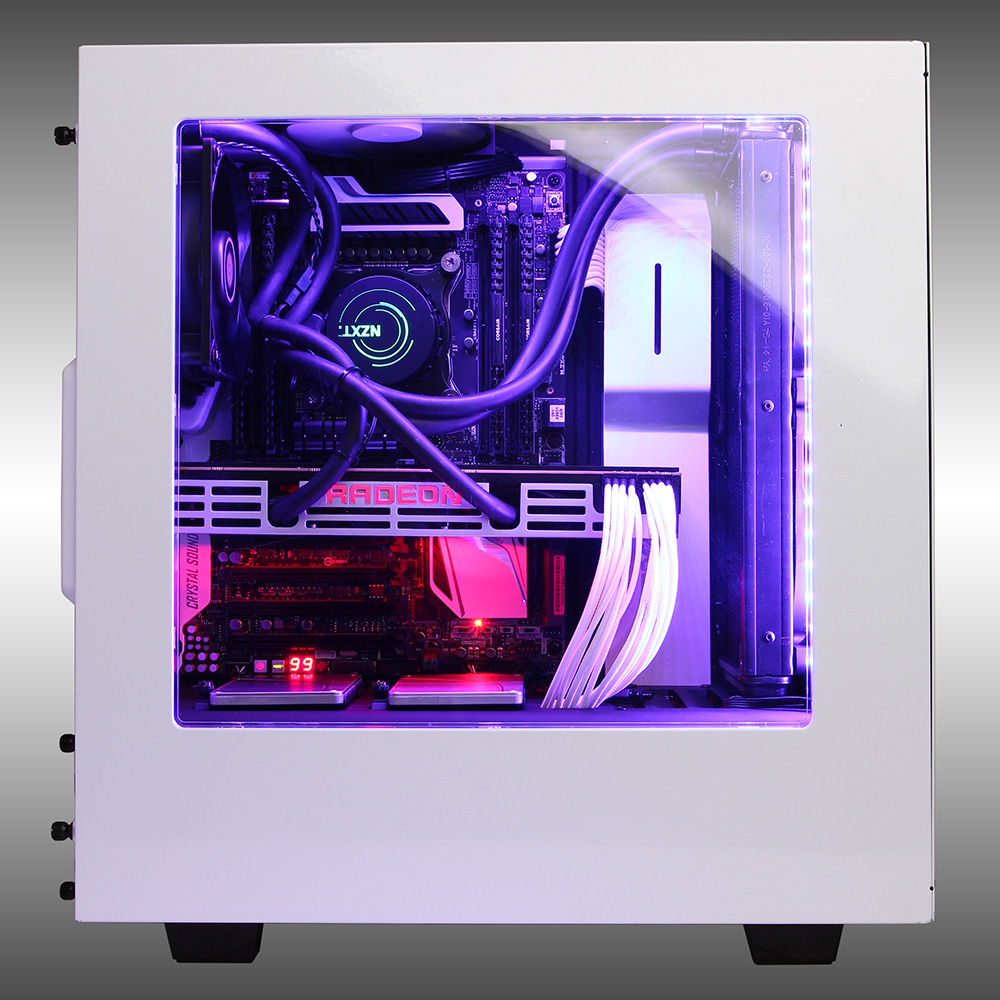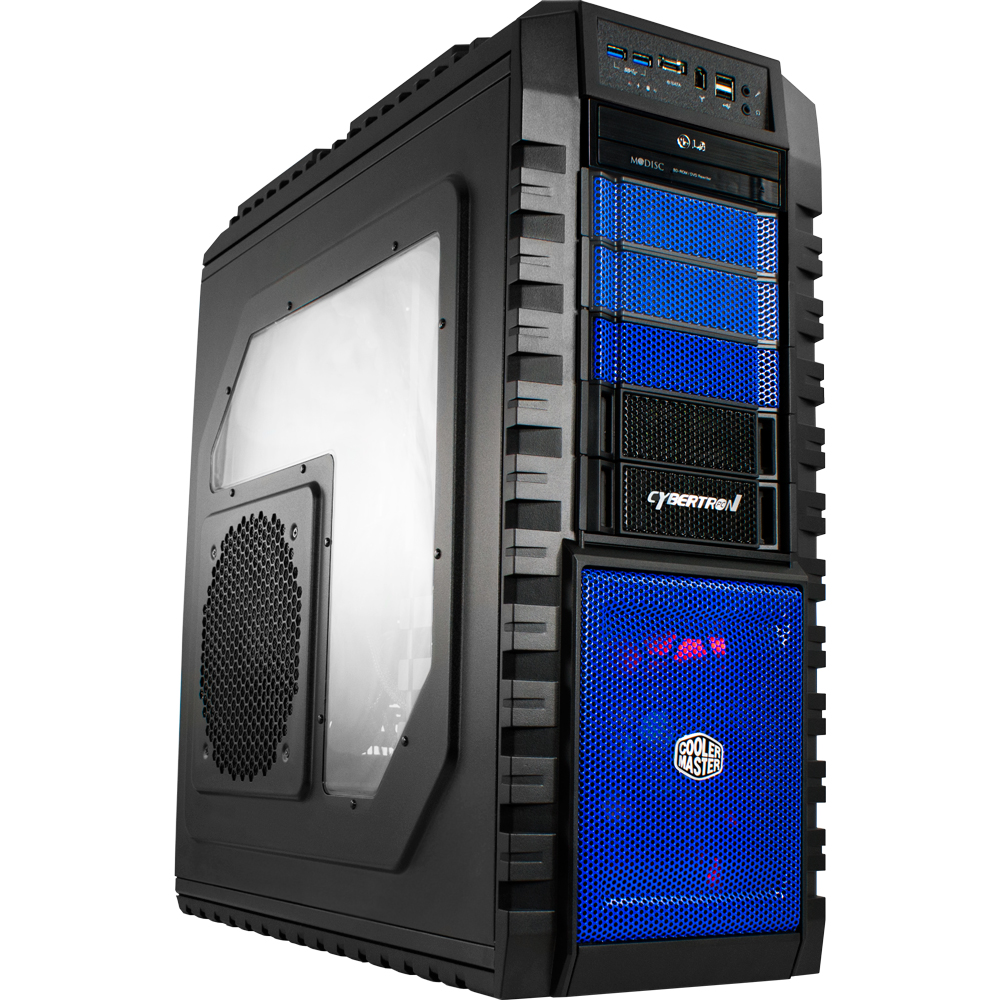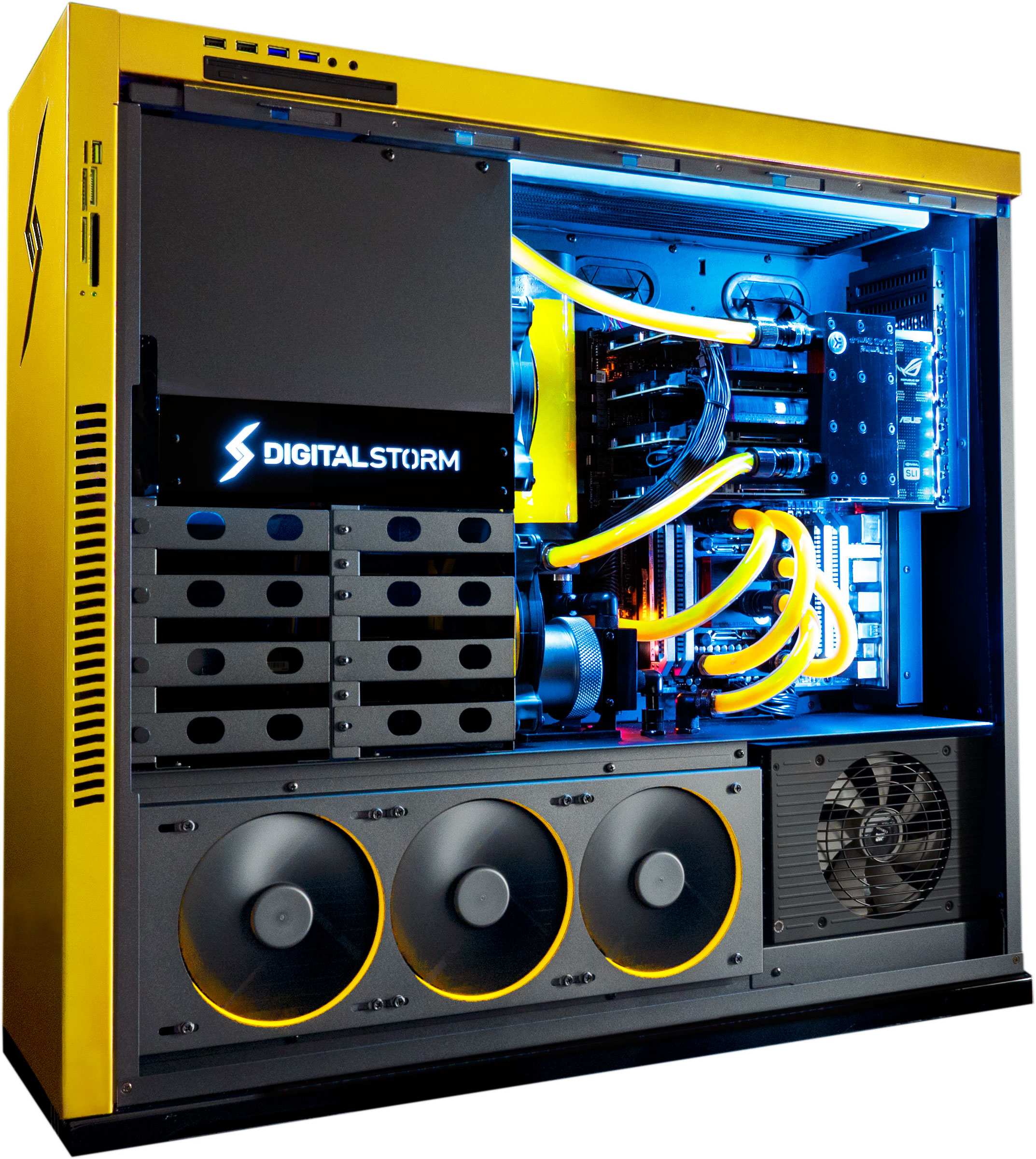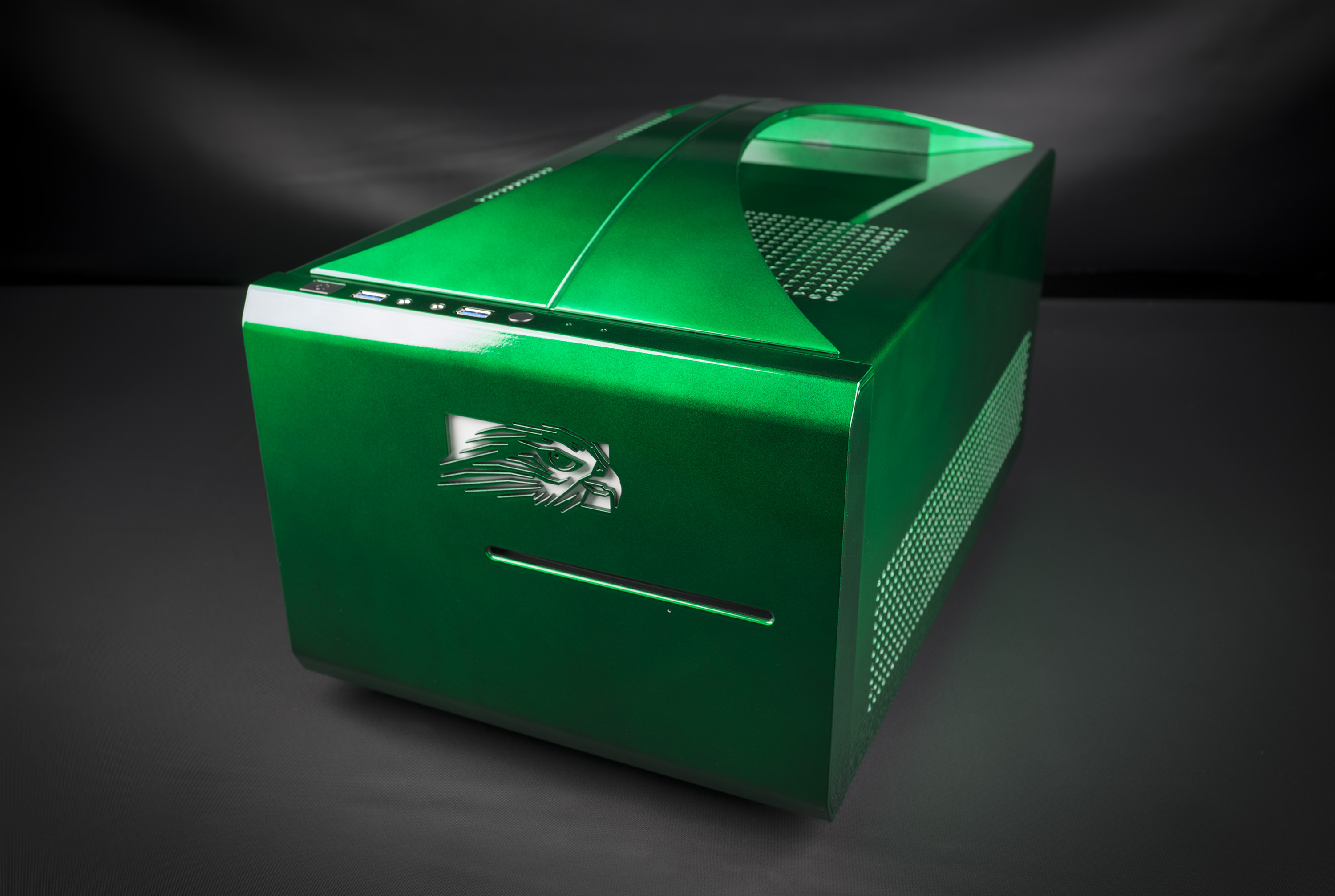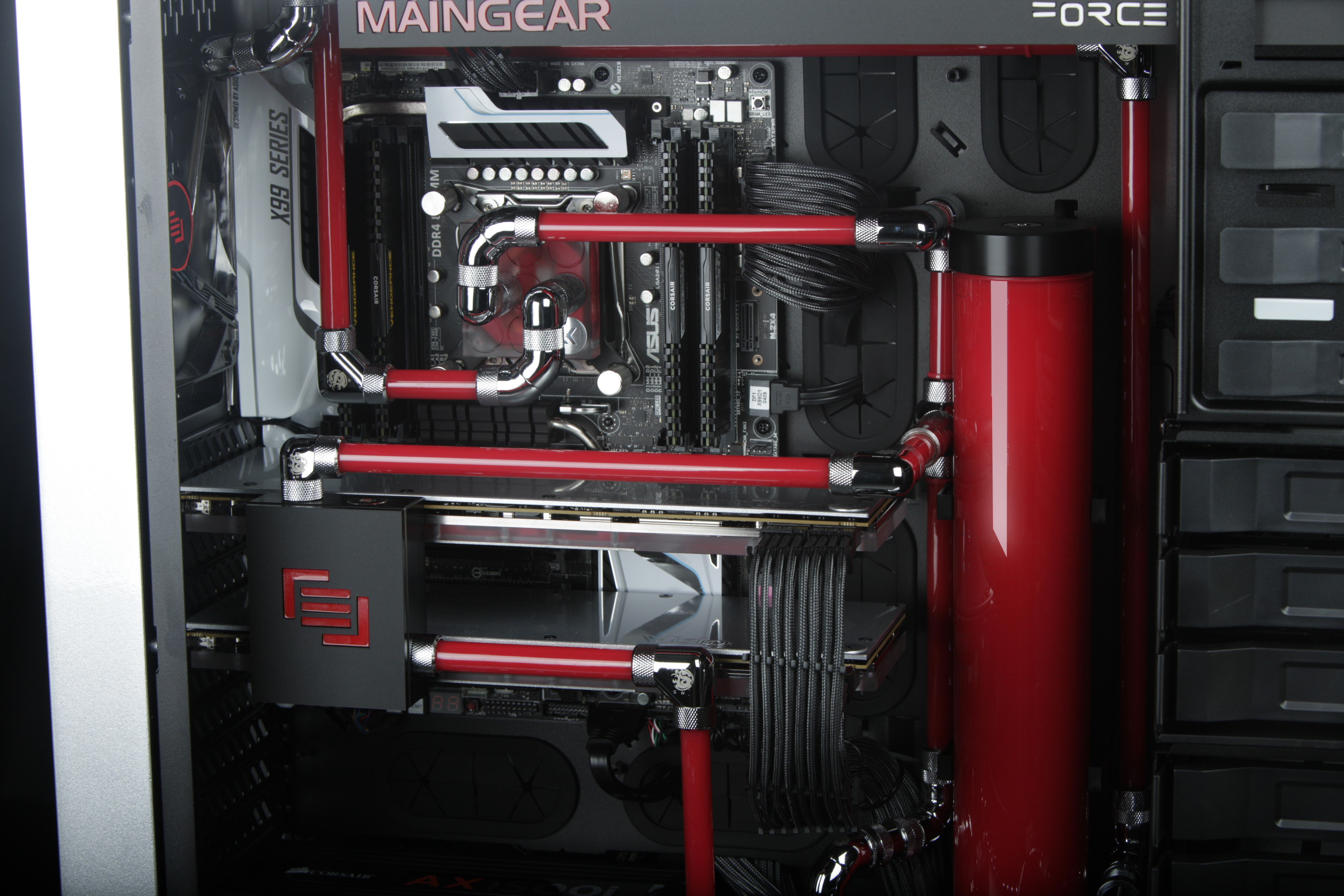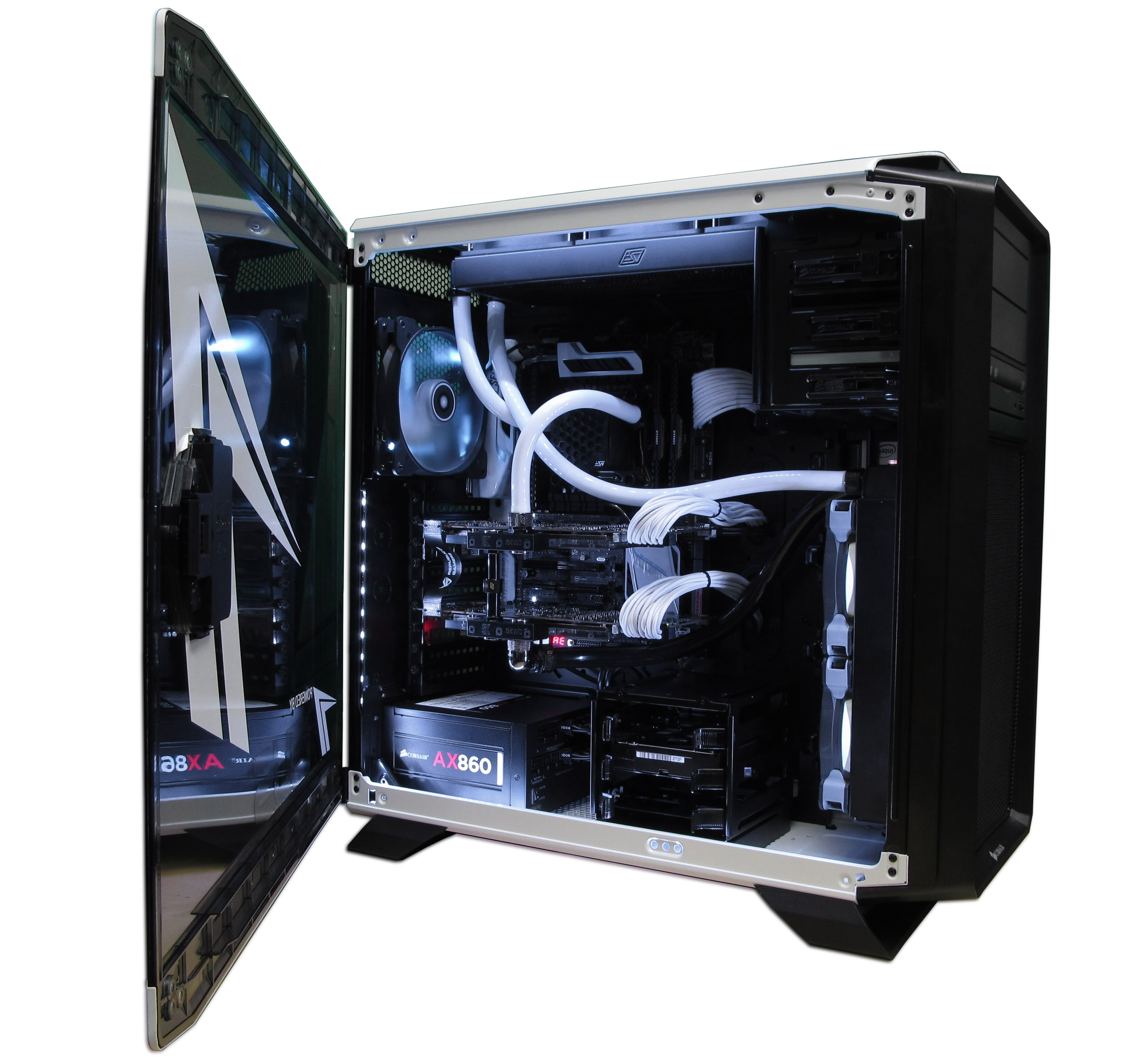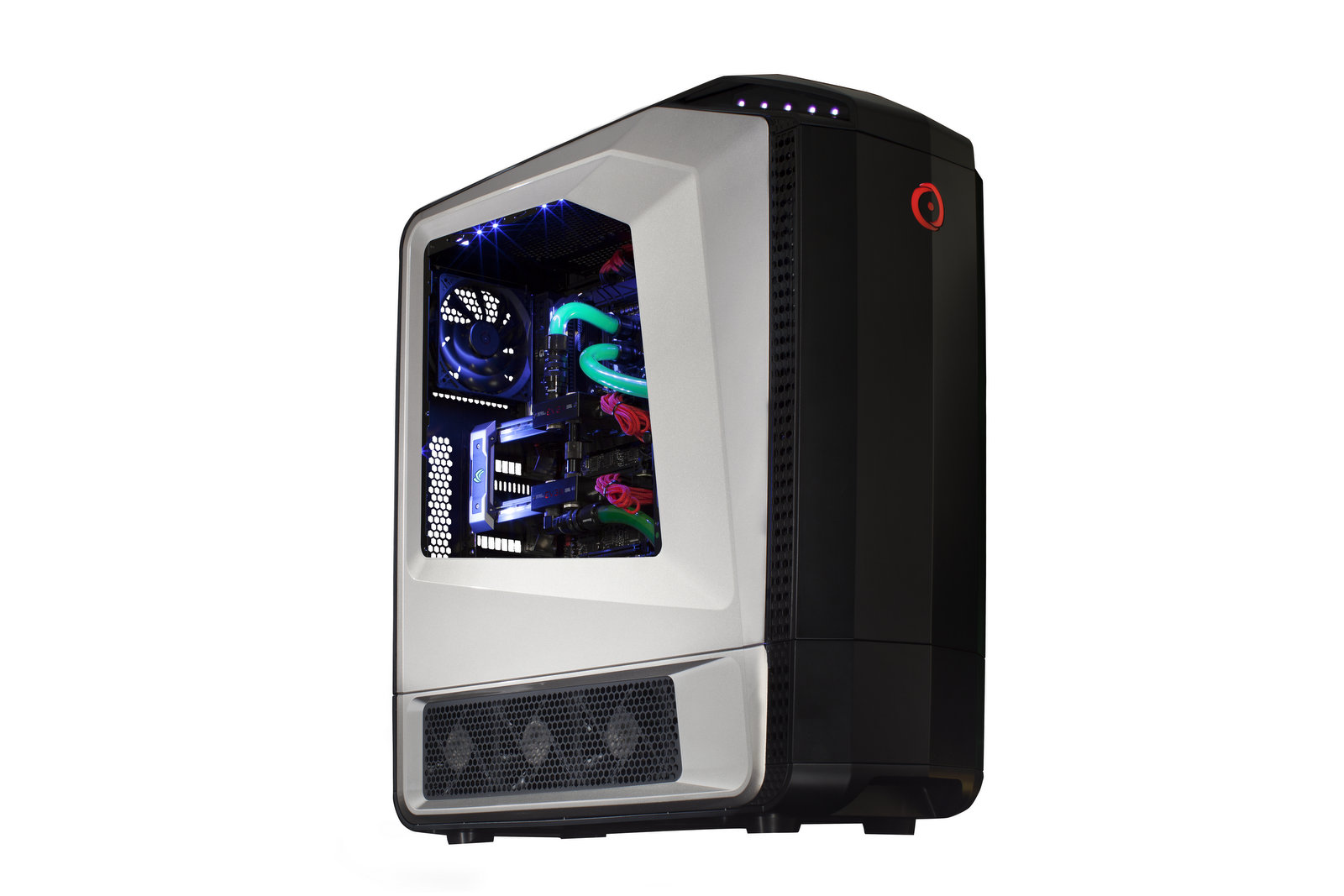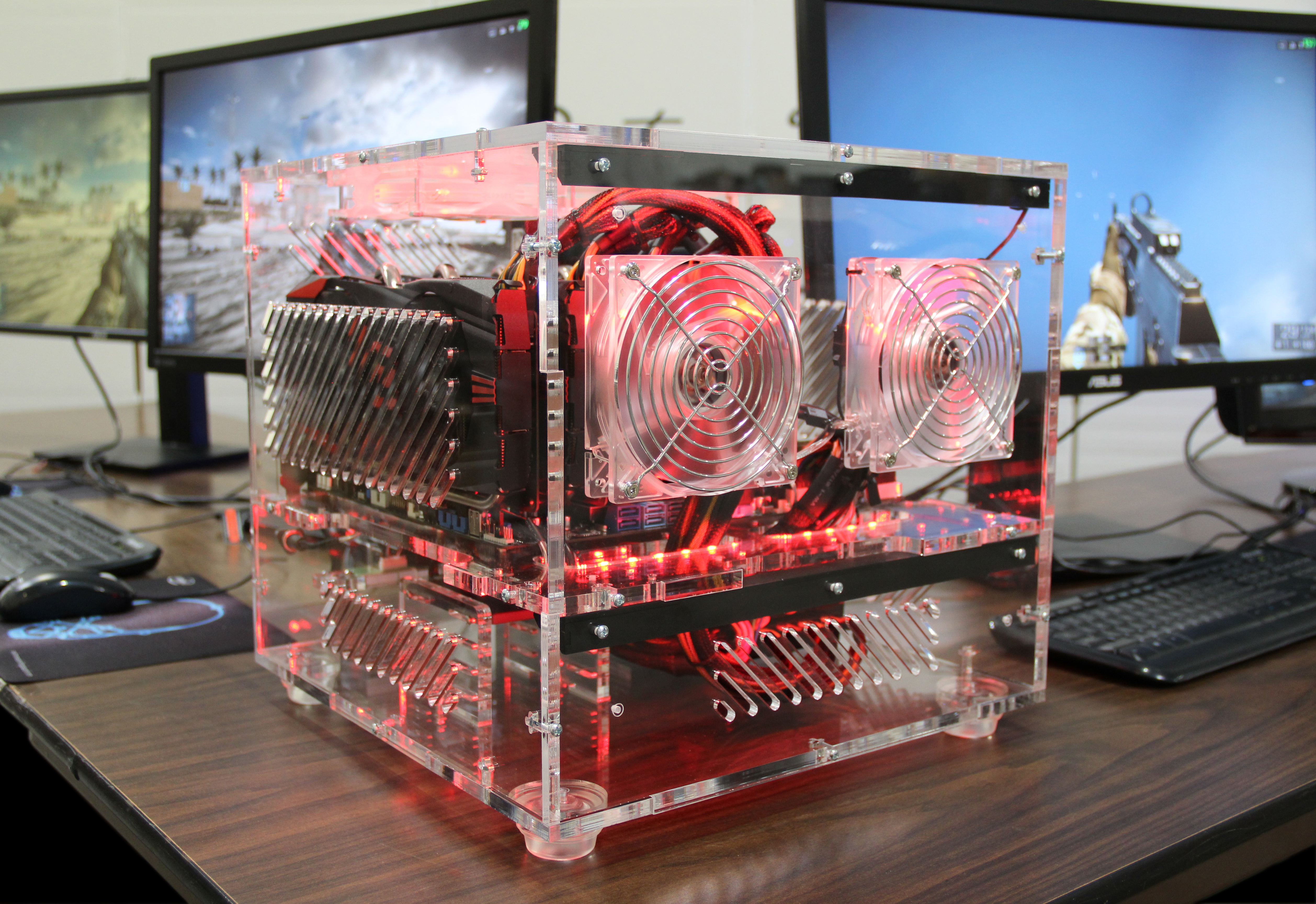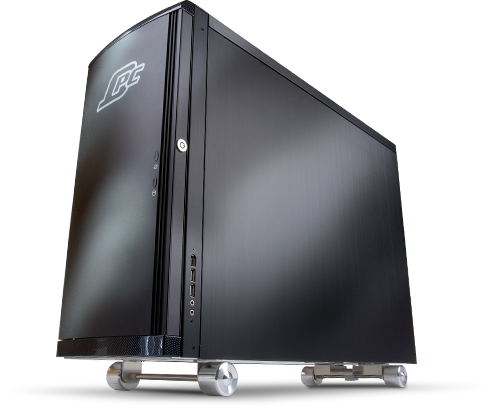Tom's Hardware's Haswell-E-Based Builder Sweepstakes
Tom’s Hardware Does It Again!
Last year, shortly after the introduction of Haswell, we teamed up with Intel to give away a boatload of processors, motherboards, and SSDs. Well, as you know, Haswell-E was introduced a couple of weeks ago, along with a new chipset, processor interface, motherboards, and memory technology. Check out Intel Core i7-5960X, -5930K And -5820K CPU Review: Haswell-E Rises if you missed it. The upgrade is potentially pretty pricey. But we’re here to help. Intel sent over 10 Haswell-E-based CPUs and 10 SSDs, which we’re giving away to 10 lucky hardware enthusiasts.
So how do you win? Read on…
In the pages that follow, we have 11 computers from our favorite system builders based on Haswell-E CPUs. By virtue of their six- and eight-core processors, all of them dutifully serve as potent workstations. But with either 28 or 40 lanes of third-gen PCI Express connectivity available, it’s too tempting to couple Intel’s latest with multiple high-performance graphics cards, too. Most of these PCs are highly capable gamers as a result.
Of course, when you spend big bucks on top-shelf gear, aesthetics matter. While we’ve already put together several of our own Haswell-E configurations in the lab, one thing we appreciate is the meticulousness today’s top builders use in making sure their wares are dressed to impress. Some of these systems look downright stunning.
Flip through the systems, check out their specs and prices, and then click the contest link on the last page to tell us which three of these configurations are your favorites. Base your decision on potential performance, form factor, price, or a particularly well-planned balance of parts. Whatever's most important to you!
At the end of the contest, the top three will be given Tom's Hardware Approved awards, so make those votes count. In the process, you'll be entered to win one of the 10 aforementioned prize packages.
AVADirect
Our first entry comes from AVADirect. It puts an emphasis on Haswell-E’s warm 140 W TDP and cooling it quietly with a nice, big Phanteks PG-TC14. Dubbed the Core i7 X99 Low-Noise Custom Gaming System, AVADirect doubly impresses by getting a Core i7-5930K-based platform out the door for under two grand ($1937.49 at the time of writing, to be exact).
Get Tom's Hardware's best news and in-depth reviews, straight to your inbox.
For that price, you also get Gigabyte’s X99-UD4 motherboard and 16 GB of Crucial’s DDR4-2133 memory across all four of the processor’s channels. The platform drops into an attractive NZXT H440 chassis with a matte black finish. And it’s driven by a 650 W Seasonic power supply, which has plenty of headroom to support mid-range GPUs in multi-card arrays.
As quoted, this quiet config includes a GeForce GTX 760 2 GB card for mainstream gaming. Consider adding a second one in SLI. AVADirect includes a 1 TB Seagate hard drive for storage as well. If you could get by with less capacity and crave the responsiveness of an SSD, the company will step you up to a 128 GB Crucial MX100 for just $17.
Something else to keep in mind: the Core i7 X99 Low-Noise Custom Gaming System doesn’t include an operating system by default. If you have your own Windows key, call that $100 bucks you can save. AVADirect does give you three years of parts and labor warranty coverage though, adding real value in one of the best places a system builder can.
You can start with AVADirect’s submission to our contest here, and play with the configurator for an extra bit of customization.
CyberPower PC
I was actually surprised (pleasantly) that a number of builders chose to create Haswell-E-based systems with reasonable price tags. The folks at CyberPower PC went a different direction to achieve platform balance, but we think the combination of parts makes good sense.
In my review of Intel’s three Haswell-E-based CPUs, I chose the Core i7-5820K as the smartest option for value, since it gives you six cores, 15 MB of L3 cache, an unlocked multiplier, and enough PCI Express for two- and three-way graphics card arrays. CyberPower uses that processor as a foundation for its Gamer Infinity 8000, dropping it onto a Gigabyte X99-UD4 motherboard with an NZXT Kraken X61 closed-loop liquid cooler. The CPU isn’t overclocked, but CyberPower includes the hardware you need to handle that on your own.
Sixteen gigabytes of G.Skill DDR4-2400 memory represent the high-end space well. And if that wasn’t enough, you also get a Radeon R9 295X2 graphics card with two Hawaii GPUs on-board, a 256 GB Adata SP610 SSD, a 2 TB mechanical hard drive, and a 1000 W Corsair power supply, all crammed into an NZXT Source 340 chassis.
How does CyberPower PC do all of that, even including a copy of Windows 8.1, a keyboard, a mouse, and three years of warranty coverage, for $2299? The CPU, memory, and graphics card alone sell for almost $1650 on Newegg. But the deal’s real, and can be further customized if you wish.
CybertronPC
Last year, when we ran our Haswell-based system builder contest, CybertronPC entered with a compact box based on BitFenix’s Prodigy. For the introduction of Haswell-E, the company appropriately steps up to something bigger, badder, and correspondingly expensive.
Its 5th Wave centers on Intel’s Core i7-5960X—the eight-core beast with a 3 GHz base clock rate and 3.5 GHz peak Turbo Boost frequency. That processor drops into Gigabyte’s X99-Gaming 5 motherboard alongside a staggering 32 GB of DDR4-2133 memory.
Those decidedly flagship-class components are fed data quickly by a pair of 240 GB Intel SSD 730 drives in RAID 0. Of course, CybertronPC knows that an all-solid-state subsystem would be prohibitively expensive, so it also includes a 2 TB disk drive for storing your pictures, videos, and documents.
Graphics duties are handled by a Radeon R9 290X 4 GB, the quickest single-GPU card AMD sells. And there’s plenty of room for another if you choose to go CrossFire somewhere down the road, thanks to Gigabyte’s motherboard and a 1200 W power supply.
CybertronPC packs those components into a custom-painted Cooler Master HAF X tower with a black and blue scheme. It also bundles Logitech’s G105 keyboard and G100S mouse, along with Windows 8.1 Professional. The 5th Wave does sell for a pricey $4500, but includes one year of parts and labor coverage, plus lifetime technical support.
Digital Storm
Digital Storm takes the decadence of a high-end PC and adds exclusivity with its Aventum II. A year ago, we covered the conceptualization and creation of this beast in The Making Of Digital Storm's Copper Tubing-Filled Aventum II. Even today, it remains in a class of its own.
The configuration Digital Storm submitted is punctuated by a $12,286 asking price. If that’s realistic for you, expect a Core i7-5960X processor overclocked to somewhere between 4.5 and 4.8 GHz (range-based tuning happens on a per-CPU basis), enabled by the company’s HydroLux Level 1 cooling solution. Yes, it’s liquid-based, and Digital Storm puts yellow coolant in the lines to match its gorgeous, hyper-yellow custom paint job.
Intel’s flagship processor drops into an Asus X99 Rampage V Extreme motherboard, which also hosts 32 GB of Corsair’s Vengeance LPX memory at 2800 MT/s data rates. Storage is both fast and copious, consisting of two 512 GB Samsung 840 Pros in RAID 0 and a single 4 TB Western Digital Black hard drive.
As you might expect for more than 12 grand, this Aventum II’s graphics subsystem is absolutely brutal. In fact, with four GeForce GTX Titan Black cards, each with 6 GB of GDDR5, in four-way SLI, you’re going to struggle to find titles that’ll scale to fully utilize the hardware’s potential. Hopefully you have an Ultra HD monitor or three to really push those four GK110 GPUs. Corsair’s 1500 W AX1500i backs them up during intense gaming sessions.
Digital Storm guarantees its show-quality system with a one-year parts warranty and three years of labor coverage. You get lifetime tech support, and can get free labor on hardware upgrades, so long as you buy the parts from Digital Storm. The inclusion of Windows 8.1 is a barely notable addition when you’re paying for such a bespoke platform. But you have to see (and hear) the Aventum II to believe it. Even though this thing uses 17 cooling fans, a lot of design effort goes into keeping it running quietly.
Falcon Northwest
Haswell-E seems to scream out for a full-town chassis crammed with high-end hardware able to tap into tons of PCI Express connectivity, right? Indeed, that’s the angle most system builders go with Intel’s Core i7s. But the folks at Falcon Northwest are resurrecting a name we haven’t seen in a while—believe it or not, the FragBox is completely capable of coping with Core i7’s thermal load (plus a couple of graphics cards).
We went ahead and completely decked out a FragBox with Intel’s Core i7-5960X, overclocked to a non-specific clock rate deemed safe by Falcon Northwest’s techs (a free add-on, no less). It sits in an X99-based EVGA Micro motherboard, is cooled by an Asetek closed-loop system, and is fed by 32 GB of DDR4-2800 memory.
Even though you wouldn’t think a small form factor has the room for a well-balanced performance build, the FragBox is well-engineered to also accommodate two GeForce GTX Titan Black graphics cards and the 1200 W power supply needed to drive a bunch of overclocked components. You even get surprising storage flexibility. We picked a pair of 1 TB Crucial M550 SSDs, but an empty bay takes up to two more 2.5” drives or a 3.5” disk, allowing a compelling tiered subsystem.
Given its exclusive pedigree, we sprung for the Exotix single-color paint job and white light chassis logo insert. Windows 8.1 Professional, a USB rescue drive, and a three-year warranty complete the package that adds up to a $7061 price tag. The company’s configurator is accessible here.
Maingear
Thus far, we’ve seen some affordable Haswell-E-based systems and other, more decked-out PCs. When they’re done right, we get excited either way. Maingear is one of those system builders known for its high-end machines loaded with custom features. The Force it submitted for our contest continues that rich tradition with an eight-core -5960X overclocked to 4.4 GHz.
By now, a great many of the parts are going to look familiar. Asus’ Rampage V Extreme seems to be a popular choice in the ultra-high-end space, as does Corsair’s 16 GB Vengeance PLX DDR4-2800 memory kit. We know that a pair of 500 GB Samsung 840 EVO drives in RAID 0 are going to deliver blazing-fast storage performance, and the 3 TB Seagate Barracuda XT is a nice nod to the folks with massive media libraries better-held on big mechanical disks rather than precious solid-state space.
Really, Maingear’s Force stands out because of its commanding Corsair Obsidian 900D chassis (windowed, of course), and Epic Superstock liquid cooling system inside. Instead of hoses running between the pump, radiators, and blocks, you get straight runs, shiny fittings, and colored coolant. Everything matches. Most of the fans are cleverly hidden. And the tubing is laid out to look like a complex science experiment. It’s all quite elegant.
It’s all very functional, of course. Maingear uses the thermal capacity of its cooling solution to not only cover Intel’s overclocked Core i7, but also a pair of Radeon R9 295X2 graphics cards in four-way CrossFire. You need lots of power output to support such a setup, so Maingear leans on Corsair’s AX1500i with custom cabling. The result looks great inside the Force; as with the tubing, power cable runs are neat, symmetrical, and only visible where they need to be.
That craftsmanship doesn’t come cheap. The configuration in question sells for $10,586. Then again, if you’re going to splurge on the best hardware available, it needs to look good, right?
NCIX PC
We’re enthusiasts, and we love talking to other enthusiasts. The folks at NCIX pC were so excited about our contest that they wanted to jump on the line to chat about what they’re doing with the ROGueX Tier 2. It was good to hear the company is building a decidedly screaming-fast PC that, while expensive, forgoes some of the flair in favor of a less shocking price tag.
NCIX PC starts with the six-core -5930K on Asus’ X99 Deluxe motherboard (does that model name make a little more sense now?). It then drops in four Corsair Vengeance LPX DDR4-2800 modules, adding up to 16 GB. The host processor is topped by Corsair’s H100i closed-loop system by default, though the crew at NCIX stepped up our contest submission to the Stage 2 custom liquid cooling option, covering the CPU and up to two graphics cards. The TurboHydro graphics loop could be a good idea too, since the ROGueX we priced out includes two Asus GeForce GTX 780 Ti DirectCU II cards that recirculate heat back into your chassis. And you still get full warranty coverage on those boards too, despite their custom cooling.
Heavy reliance on Corsair’s portfolio carries over to the Graphite 760T case, AX860 power supply, and LED-lit AF140 cooling fan. We don’t have a problem with this; Corsair makes a lot of good hardware. But NCIX PC goes a different direction for storage, tapping Intel for its SSD 730. Western Digital's 2 TB Black, spinning at 7200 RPM, handles the user data you don’t need eating up solid-state capacity. Alternatives include the 3 and 4 TB models.
Recognizing that many power users continue using Windows 7, the ROGueX comes with a 64-bit build of Home Premium. Stepping up to Professional adds $53 to the quoted $4498 price tag. You can read more about the ROGueX on NCIX's landing page.
Origin PC
We don’t get to review many complete systems, but we definitely keep an eye out for the builders innovating beyond the traditional PC concept. Earlier this year, Origin PC gave us an exclusive look at its Project Prime, which turned into the Genesis and Millenium systems. If you didn’t catch that piece, check it out. In short, though, variable mounting, a configurable front door, mid- to full-tower expansion, and remote-controlled lighting were some of the features we dug about Origin’s chassis concept, designed in-house for its newest machines.
It was hardly a surprise, then, when Origin PC submitted its Genesis for our contest. Sporting a Core i7-5960X on an Asus Rampage V Extreme motherboard, the PC can be overclocked to operate as fast as 4.7 GHz through the Cryogenic Stage III Liquid Cooling configurator option. Company representatives acknowledge that each chip is different, and not all of them will hit the high water mark. However, they do look for the top clock rate per CPU within a safe voltage range. Longevity is important here too, since Origin’s standard support package includes lifetime 24/7 tech support, lifetime labor, one-year part replacement, and 45-day shipping coverage. An extra $269 gets you a three-year parts replacement guarantee and free shipping. You can bet the company wants to be extra sure your system is stable—its signature wooden crate can’t be cheap to move.
Count Origin PC amongst the builders looking to Corsair for fast (2800 MT/s) DDR4 memory. Our configuration ships with 16 GB in a quad-channel arrangement. A 1 TB Samsung 850 Pro feeds data up the storage hierarchy as quickly as possible, while 6 TB of mechanical storage are perfect for even the largest collection of backed-up movies and music.
And games. Don’t forget games. Origin PC outfits this beast with two GeForce GTX Titan Z cards boasting 8 GB each and outfitted with the company’s Cryogenic liquid-cooling solution. Again, Corsair’s 1500 W AX1500i provides the juice needed to support the industry’s highest-end hardware under load.
In addition, you get PowerDVD 14 Ultra (to go with a 16x Blu-ray burner), Windows 8.1 64-bit, a USB 3.0 recovery flash drive, and an Origin PC t-shirt. The price of entry? $9,999. You can find more detailed info on the Genesis here.
Puget Systems
Puget Systems gets credit for the most unexpected submission to our contest. The company has 14 years of experience building enthusiast-oriented PCs, with much of that also spent elbows-deep in servers and virtualization. It brings those two worlds together with its Multi-Headed VMWare Gaming PC.
This high-end configuration employs an overclocked (and water-cooled) Intel Core i7-5960X processor in an Asus X99-E WS motherboard, 64 GB of DDR4-2133 memory, and, most important, four Radeon R9 280 graphics cards (Nvidia’s boards aren’t compatible).
The system is set up with a 1 TB Samsung 840 EVO and a 256 GB 850 Pro SSD. The first drive boots into a standard Windows 8.1 operating system, giving you a classic high-end PC with more performance potential than you'd know what to do with. But the magic happens on the second drive. Press F8 during the boot process, select the second SSD, and you load up into the world of virtualization.
Puget Systems divides up the system resources, creating four virtual gaming PCs, each with its own dual-core CPU, 8 GB memory, 250 GB SSD, two USB ports, and Radeon R9 280 with 3 GB of GDDR5. Up to four gamers can connect directly to this PC and game on their own displays. There’s no funky streaming involved, so lag doesn’t get added to the experience. Since the PC is virtualized, you can even create more virtual machines, hosting game servers or file servers for your LAN party. Puget recently showed off this concept with last-generation hardware at PDXLAN 24, giving four gamers the ability to play Battlefield 4 on one machine. The setup is made even faster thanks to Haswell-E.
Company representatives recommend liquid cooling for the four stacked video cards, so liquid cooling blocks are included in the $7841.50 price tag we were quoted for a virtualized gaming system of our own. The whole configuration fits into a Fractal Design Arc XL chassis, and is driven by an EVGA SuperNova 1200 W power supply. Of course, software is a crucial consideration here; Puget includes five copies of Windows 8.1 and VMware vSphere 5.5. But before you whip out your credit card, give Puget a call—there’s a lot of customization that goes into a specialty offering like this one.
Velocity Micro
Are you suffering from sticker shock yet? Velocity Micro has something it hopes will bring Haswell-E ownership back into the realm of realism for enthusiasts on a budget. Its Raptor Signature Edition employs the company’s all-aluminum OPC mid-tower chassis mounted up on aluminum wheels. It’s a Lian-Li case, so it’s naturally clean, classy-looking, and quiet.
That sounds like it’d be the start of an expensive configuration. However, the Raptor configured for us ducks in just under $4000. And yet it still includes a liquid-cooled Core i7-5930K processor on Gigabyte’s X99-Gaming 5 motherboard with 16 GB of Crucial DDR4-2133 memory.
We particularly appreciate parts lists that take balance into consideration, and Velocity Micro’s does. The company might have gone with the slightly-slower Core i7-5820K and added more graphics muscle. However, that’s a judgment call dependent on the applications important to you, and the single GeForce GTX 780 Ti in this Raptor Signature Edition is still considerable. So is the 500 GB Samsung 840 EVO, backed by a 1 TB hard drive. Given a limited storage budget, lots of flash and an even larger disk yield the best mileage. Gigabyte takes care of audio with an on-board SoundBlaster X-Fi MB3 and networking through Qualcomm’s Killer E2201 GbE controller.
Velocity Micro’s offering is rounded out with Windows 7 Home Premium, a t-shirt, a one-year parts and labor warranty, lifetime tech support during regular business hours, and a lifetime upgrade plan that covers getting your system shipped back for maintenance, upgrades, and tuning.
-
MarkW I read through all the systems, and made notes on the ones I would be likely to buy, and went to the contest page and filled out everything there, and submitted my entry, and failed to find anywhere to list or choose my 3 favorites. So I don't know what is going on, but I have my 3 favs selected, and got no place to enter them...Reply -
twkr Cyberpower PC with that configuration looks fantastic, has components that are great and it's priced right. That makes it stand out above the rest. Plus, it's a hassle-free closed loop for both the CPU and GPU? Yes please!Reply
Digital Storm makes beastly builds, it's tough not to want something that sexy and who wouldn't want four-way SLI with Titan Blacks? It's over the top, though you'd expect two 4 TB HDDs in RAID 1, if you're going all out.
The FragBox from Falcon Northwest also stands out because of the form factor, though it's still steep. Two Titan blacks and all the other goodness packed in a case that's mobile begs for a 4K projector and a LAN party, provided that HDMI 2.0 for full 4K at 60 FPS is feasible. -
rolli59 Xotic PCReply
Puget systems
NCIX
Were the 3 that caught my eye but like others, filled in the contest form and no place to vote! -
xyriin The Maingear system with the red piping looks awesome. For similar reasons I like the yellow Digital Storm system. To round out the top three I'd also add the NCIX system.Reply -
CaedenV Digital Storm, NCIX, and the cute little falcon NW box would be my favorite 3 of the bunch.Reply
Hope I win! -
markwp @MarkWReply
I have the same problem - read, make notes, etc., but no place to vote for any rig. I suspect a conspiracy due to our names being similar :}
MarkWP -
Joshua Dudash Digital Storm, NCIX and the Falcon Northwest builds looks the best to me. Good luck everyone!Reply
